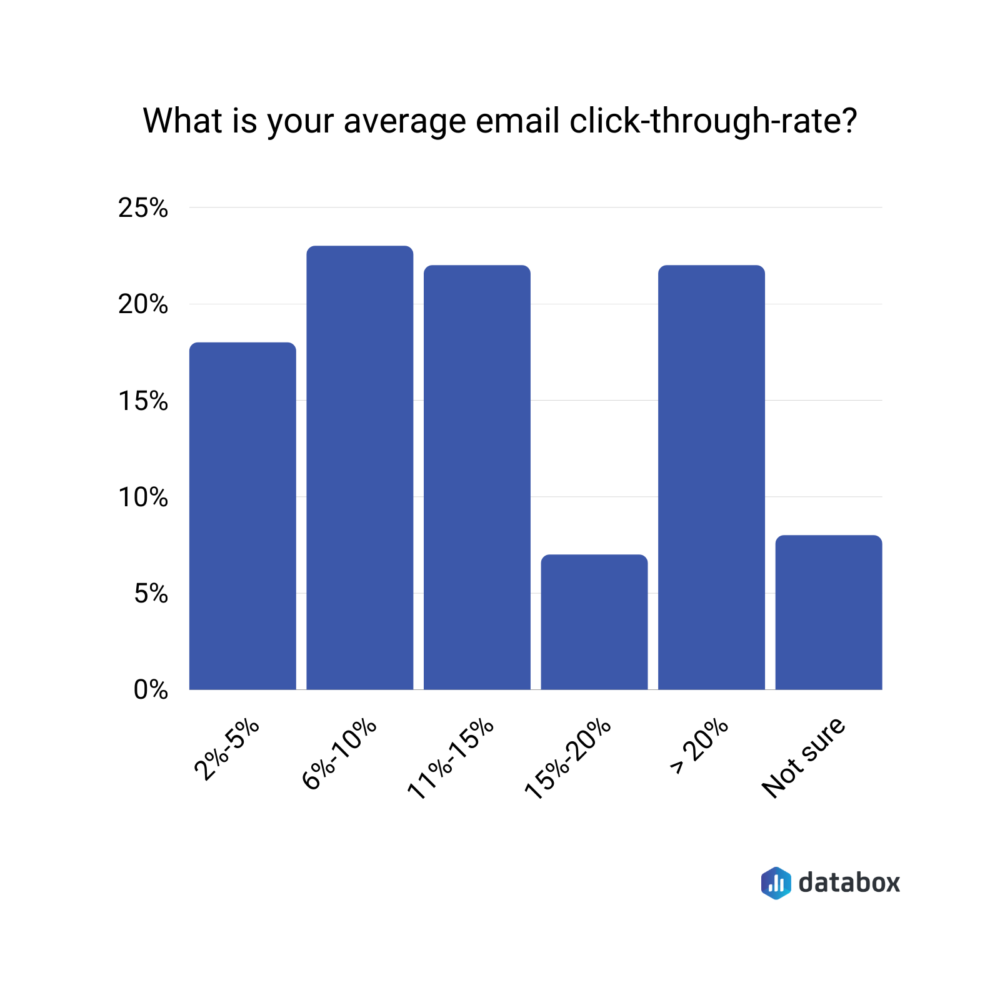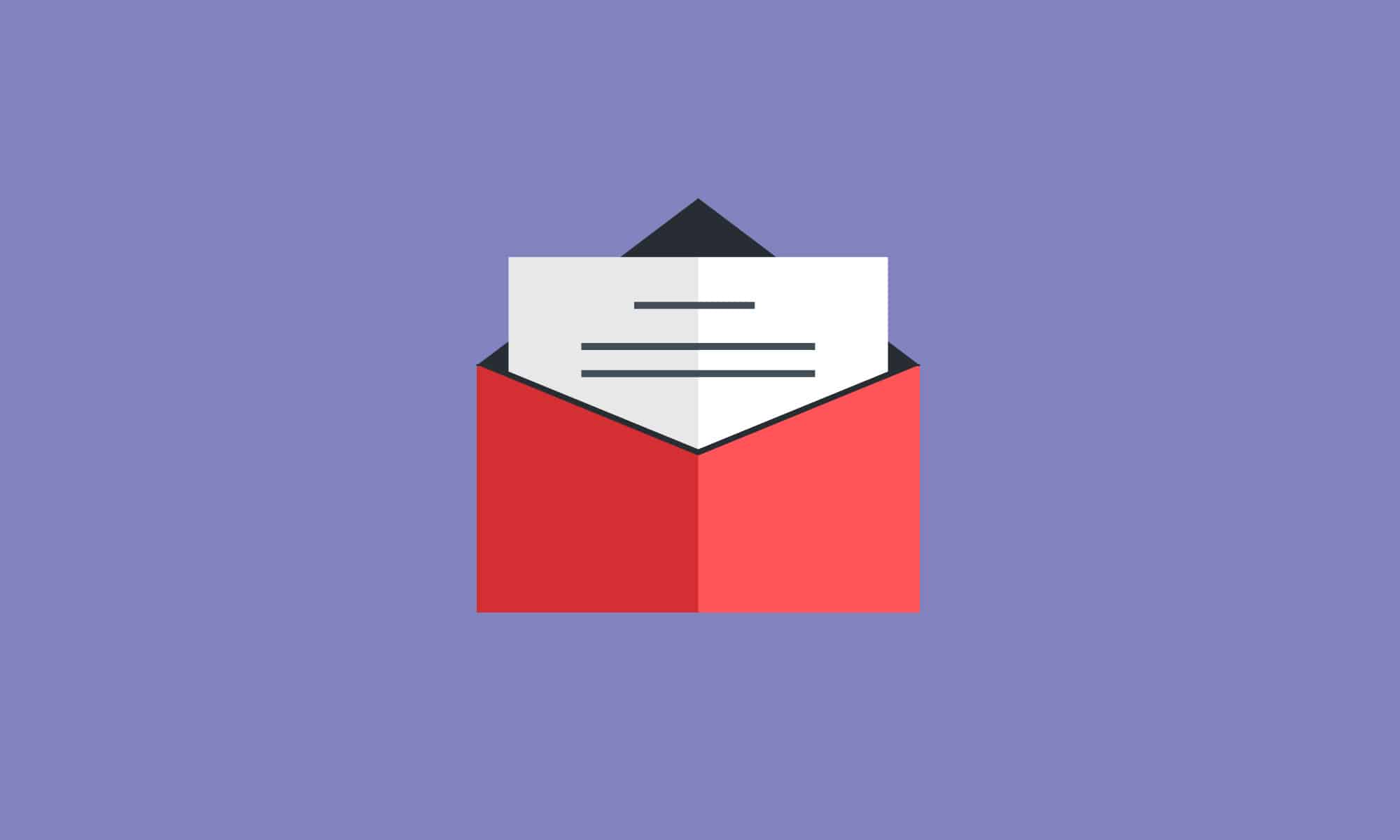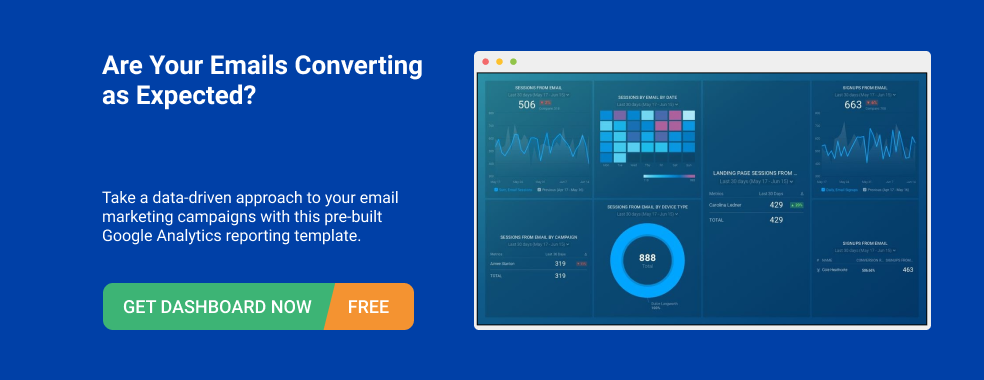Table of contents
Email marketers spend a lot of time optimizing delivery and open rates with the goal of getting clicks, and ultimately conversions.
But besides the clicks themselves, there are a number of factors that will determine your aggregate email click-through-rate.
Such as:
- How engaged is your list?
- How frequently do you send emails to that list?
- What time of day are you sending the email?
While most teams would say they have a handle on these factors, it’s actually a bit tricky to understand things like engagement, send time, and frequency at the subscriber level.
Ready? Let’s dig in.
In this guide you’ll learn:
- What is Email Click-through Rate (CTR)?
- What is a Good Click-through Rate for Email?
- 9 Unique Ways to Improve Email Click-through Rate (CTR)
What is Email Click-through Rate?
Email click-through rate is a metric that measures (in percentage) the total number of people that received your email and clicked on at least one link within the email message (either a CTA, hyperlink, an image, etc).
How to Calculate Email Click-through Rate (CTR)
Email click through rate is calculated by dividing the total number of people who clicked by the number of delivered emails and then multiplying the ratio by 100.
Email CTR = Number of clicks /Number of Emails delivered * 100
Furthermore, here are other terms you should know:
Unique click-through rate: This refers to the number of unique recipient clicks that links in an email receive. That is this metric measures how many people clicked on any link in your campaign.
Total click-through rate: This metric measures the total number of clicks that links in an email receive. Track this data in real-time using this email marketing dashboard.
Click to open rate: This metric measures how many email recipients opened the email and clicked on any link in the email campaign. It is a good way to gauge how relevant and engaging your email campaign is.
Email CTOR: Number of unique clicks/Number of Unique opens * 100. Keep an eye on this metric using this marketing dashboard software.
Editor’s Note: Looking for a simple way to track and measure your email CTR? Use Data Calculations in Databox to combine data from multiple sources and easily calculate CTR, ROI, and any other metric that you need.
What is a Good Click-through Rate for Email?
We polled dozens of marketers in order to identify any commonalities in email click-through rate. Turns out, there weren’t any.

Most surprisingly, however, was that 22% of marketers reported email click-through-rates over 20% and about 25% of them said that their CTR ranges between 6-10%..
Furthermore, taking into consideration Constant Contact email marketing benchmark in which 200 million emails sent by their customers were analyzed, we can see that the overall average email click-through rate across the industry as of April 2021 is 10.65%
9 Unique Ways to Improve Email Click-through Rate
To gain some practical tips on how to improve email click through rate, we asked our pool of email marketing experts to weigh in. Here’s what we learned:
- Nail Your CTA
- Use a compelling subject line
- Offer value
- Segment your email list
- Personalize your email
- Include videos
- Keep it simple
- Test and Improve
- Keep an Open Mind
PRO TIP: Track Your Email Marketing Performance with Ease
Unsure what’s working in your email marketing strategy and what doesn’t? Feeling overwhelmed by data scattered across multiple platforms and reports?
Get a clear and centralized view of your campaign performance with our free email marketing dashboard templates – pre-built with essential metrics and KPIs from the most popular email marketing platforms, all in one place. See what’s working (and what’s not) with your email marketing, optimize campaigns, and maximize your return on investment.
Monitor engagement: Keep tabs on essential metrics such as open rates, click rates, and subscriber growth. Learn how your audience interacts with your emails and optimize your strategies accordingly.
Optimize campaigns: Identify your top-performing campaigns and landing pages with templates such as the Mailchimp Campaign Performance and HubSpot Marketing Performance dashboards. Analyze user activity, conversion rates, and campaign ROI to drive better results.
Understand traffic sources: Dive deep into your traffic data with the Website Acquisition Overview template from Google Analytics 4. Monitor where your users are coming from, their behavior on your site, and how it all ties back to your email campaigns.
Improve deliverability: Track your email delivery rates, open rates, and click rates to ensure your messages are reaching your audience and performing well.
You can easily set it up in just a few clicks – no coding required.
To set up a dashboard, follow these 3 simple steps:
Step 1: Choose a fitting template
Step 2: Connect your data
Step 3: Watch your dashboard populate in seconds
1. Nail Your CTA
If you want people to click your emails, you need to give them a good reason to do so. Which is why so many of our respondents mentioned strategies for using great calls to action (CTAs) in emails.
More than anything else, marketers said to stay focused and only include one CTA.
GoodFirms‘ content consultant Kim Smith lays out her strategy saying:
“A singular CTA button works the best,” said Smith. “It’s simple. Put a short, concise text in the email explaining what would a customer get by clicking that CTA and put a big, bold, and emotion-creating CTA button out there. And end it with an elegant thanks.”
(If you need multiple CTAs, Smith says, make sure to distinguish each one so there’s no confusion.)
Why is a single CTA so effective?
It “forces all content to feed to this outcome,” said Eric Quanstrom, CMO of CIENCE. “Especially the rationale for why you are writing and the value proposition.” That idea of value proposition is a big one; we’ll talk about that more in a moment.
Arielle Kimbarovsky, digital marketing intern at Codal, also pointed out that multiple CTAs are overwhelming to readers. “Which usually just leads to them abandoning the email.”
Here are some tips shared regarding the best places to place the CTA in your emails.
Put the CTA at the Top—Or Throughout
When most people think of CTAs, they think of the standard link or image at the very end of the email.
But plenty of marketers say that’s not the way to go.
Jonathan Aufray, co-founder of Growth Hackers, muses that this is because of increased mobile use:
“If you put your CTA at the end of the email, the recipients will need to scroll down for quite some time before seeing your CTA,” said Aufray. “Putting the hyperlink around the top of the email increases the CTR.”
Not everyone recommended being quite so judicious with CTAs, though.
Roy Harmon, owner of Advertoscope, recommends sprinkling different variations on the CTA throughout the email (including early on). “A good rule of thumb is to include a linked CTA every 150 words or so,” Harmon says.
And he has results to back it up: using the CTA throughout has increased his email click-through rate by up to 12.5%.
Separate the CTA
BHW Group‘s digital marketing intern Eileen Bau shared an especially interesting way of highlighting email CTAS. Instead of placing them at the top or bottom, or even throughout the email, she completely separates content and action areas.
“Links can get lost in even a few sentences of copy,” Bau says. So, she tried something different.
“I saw our CTR increase after I simply added a small sidebar section in our email that consolidated all actionable links in a very clear, concise manner,” said Bau. “Each link would be preceded only by a short, less-than-five-word description. For example, ‘Sign up today for XYZ: [link]’ or ‘Discount Offer: [link]’.”
“It helps readers visually recognize that there is one place in every email they can go to if they want to take action.”
Good read: Increase Your Conversions with 16 Proven Tips for Crafting CTAs
2. Use a compelling subject line
No matter what we’re focused on in email marketing, we almost always come back to the subject line. And it makes sense; you can’t get a high click-through rate if no one opens your email.
That’s why our respondents placed a strong emphasis on driving opens with great email subject lines.
Additionally, Fundera content marketing associate Nicolas Straut has seen results by emphasizing urgency and value.
Laura Hall, marketing executive at Shiply, also adds. “Leave a little bit of mystery in the subject line, so readers want to read more,” she says.
3. Offer value
Once you’ve gotten your recipient to open your email, you need to give them a good reason to click. And beyond a great call to action, you need to provide value.
That means something different to every company and every marketing campaign. But it’s something that came up a lot from our respondents. Of course, it’s easy to say “add value.” It’s a little more difficult to give specific examples.
demandDrive‘s director of Marketing, AJ Alonzo, shared his agency’s strategy. Instead of sending out typical marketing emails, they share specific articles and blog posts. Here’s an example that Alonzo passed along:
“Hey [PROSPECT],
Whether you’re building a new SDR team or augmenting your existing one, here are some things our network has experienced:
- There’s a shortage of SDRs, and the quality reps are expensive
- You think you have a great team, but turnover is high – now you have to re-recruit, train, and hire
- To keep that team productive you need a dedicated manager
This blog on the SDR shortage has been helpful to a lot of clients in your area: (Insert Relevant Blog Here)
Enjoy!”
It seems simple, but emails like this have gotten in the neighborhood of 6.5% CTR, which is quite a bit higher than demandDrive’s average.
Why does it work? “This way the prospect knows that we’ve done our research, we predict a common problem, and we give them a potential solution,” said Alonzo. “It’s compelling enough to get them to click on it, and we’re not pressuring them to do so.”
Daniel Ndukwu, founder of KyLeads, gave the example of a fitness email.
“I travel a lot so I like to do exercises that don’t require weights because finding a gym is a hassle. I’m also not interested in bulking up,” Ndukwu says.
“If you send me an email about ‘ten gym exercises you must do’ I’ll ignore it. If you send me an email about 10 exercises you can do right now with no equipment I’m opening, clicking, and bookmarking that page.
Ndukwu is getting into segmentation, which is a valuable tool we’ll talk about next.
Before we do, though, it’s important to mention Nedelina Payaneva’s insight. Asian Absolute‘s junior digital marketing specialist shared her thoughts on just how much value you should be providing.
“You want to dedicate about 80%, or 4 out of 5 messages, to be insightful and helpful to your customers, while only actually selling the other 20% of the time,” said Payaneva.”
4. Segment your email list
Not every customer is going to respond to the same type of value. Segmenting your email list into different groups can help you provide the right kind of value.
“Let’s face it, every email that you send probably isn’t relevant for the entire list,” says Sean Nichols, marketing manager at SiteVisibility. “Rather than sending every offer or promotion or piece of content to everyone on your list, take time to think about who it is most relevant for and create groups and segments before sending.”
There are many ways you might segment your list. Dalton Francis, director of email marketing at Giant Partners, recommends “catering to the specific wants, needs, demographic, and psychographic information of your audience.”
That’s a lot of segmentation. And it’ll require more time and effort to craft emails for each of those groups,” said Francis. “But in the end, it’s worth it. Giant Partners has seen absolutely phenomenal increases in their CTR after abandoning “mass ‘shot in the dark’ promotional emails.”
Even if you only use a small number of segments, you can create emails that are better suited for those groups. James Nuttall, content and outreach specialist at It Works, gives the example of a recruiting agency.
“You’re going to be sending out emails to people who are looking for jobs and people who are looking to fill positions within their company. Therefore, your messages are going to be completely different and your tone is going to be different.”
Editor’s note: Get full visibility of the emails you send, the responses you get including open rate, click rate, and new leads on one screen with this HubSpot Marketing Email Performance Dashboard Template.
5. Personalize your email
Beyond segmenting your email list into groups lies the murky world of email marketing personalization. Figuring out how to appeal to individual customers is the holy grail of marketing, but it’s not easy.
Personalizing emails takes time and research says Liviu Tanase, founder of ZeroBounce, “This doesn’t only mean addressing subscribers by their first name but taking the time to study their behavior and discover what they like, need, and expect from you.”
You can also personalize your emails with timing.
“To subscribers who clicked on a certain link in the master-list-send that week, we scheduled a personalized follow-up email a couple days later,” says Meenal Upadhyay, SEO associate at Fit Small Business. “We have seen 60%+ open rates and 30%+ CTR on these highly segmented follow-ups.”
6. Include Videos
Interestingly, a few marketers mentioned including videos in their emails to increase click-through rate. Including video in email is a bit of a challenge, but there are a few tactics that can work.
And when they work, they can really give you a boost.
One interesting idea we heard was to get around the difficulty of including video in an email by using GIFs instead. Joy Gendusa, founder of PostcardMania, says that GIFs have doubled her click-through rates.
That’s an easy tactic for a huge gain.
And you can combine personalization and video for even more impact. Casey Hill, founder of the Bonjoro, recommends the video messaging tool Bonjoro. It allows you to create short personalized videos that speak directly to your customer.
Editor’s note: Want to track your real-time video performance? Check out Databox’s robust integration with Vimeo
7. Keep It Simple
Email marketing—and marketing in general—has seen a shift away from ornate, complicated messages and media. If you haven’t followed that trend, you could be losing clicks.
“It’s always tempting to provide more information, more bullet points, more validation, and even more offers in your emails, but, time after time, focus and simplicity has worked for our clients and ourselves,” says Olive & Company vice president Erik Norsted.
And that goes beyond just using a single call to action.
Josh Spilker, content manager at ClickUp, recommends plain-text emails to keep things simple. (Or HTML-formatted emails without images.) It adds a personal touch, he says, and makes people more likely to click.
8. Test and Improve
Okay, so we’ve gone over a lot of potential things you can do to increase the click-through rate of your emails. But how do you know if they’re going to work?
By testing them.
301 Digital Media‘s manager of digital strategy and planning Lauren Petermeyer recommends running effective A/B tests. “Testing more than one subject line and then looking at the number of clicks from each can help you identify what kind of language is resonating with your readers. Do they like long or short subject lines? Questions? All caps?”
Continual testing to see which of your emails perform the best ensures that you know what your readers are looking for. Use marketing reporting software to track open rates for several campaigns at the time without checking each individually in your email distribution tool.
9. Keep an Open Mind
PhoenixNap president Ian McClarty told us that they’ve seen great success with sending emails that look like they’re from a person, instead of from the company. “An email that appears to be coming from an actual individual is more personal and much more likely to get opened,” McClarty says.
John Lincoln, co-founder of Ignite Visibility, emphasized withholding just enough information to capture readers’ interest. Boxless Media president Jason Baumann extolled the value of running Facebook campaigns alongside email campaigns.
By following the best practices in this article, you’ll be able to improve your email click-through rate overtime. Remember to experiment and try out various tactics in order to find what works best for your company.
What strategies have you tried to improve your CTR? Did they work? What was most effective?














